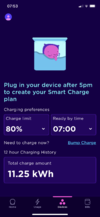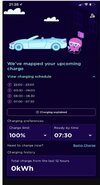Why write this post?
A lot of people are starting to get interested in IO. I don't think Octopus do a very good job of spelling out the benefits in their website. They have some FAQs, but the same questions keep coming up over and over on the forums.
What is it?
In a nutshell, IO is a split tariff that gives you a cheap off-peak rate for charging your EV and other electrical items in the household, including home batteries.
Isn’t that the same as Octopus Go or Go Faster?
The principle is the same, but in exchange for some benefits which we’ll explain, you allow Octopus to control the timing of your EV charge, so they can choose low carbon intensity and/or cheap wholesale priced time slots.
So I’m not in control of my charge? I don’t like the sound of that!
Well yes…and no. You’re in control of how much to charge and when you want the car to be ready, just like you would be normally. Within those parameters, you’re allowing Octopus to control which half-hour slots the car chooses to get to that target % charge. And you can always override IO if you want to “bump charge” through the day.
OK, but what are the benefits you mentioned for this trade off?
First of all, you get a larger guaranteed off-peak window for using household appliances and charging home batteries, etc. It’s six hours between 23:30-05:30. Go, for example, is a fixed 4 hour window.
In addition, when IO schedules your EV charging slots it sometimes creates schedules that fall outside of the fixed, six hour window. If that happens your EV charging and all your household use in these extra-slots is also charged at off-peak rates.
I have frequently had schedules give me seven or more hours of off-peak rates. On one occasion, I had a total of ten hours of off-peak rates.
Am I eligible?
You need a smart meter and a compatible car and/or charger. Since you’re reading this here, I assume you’ve got or are thinking of getting a Tesla. IO works with the Tesla API to create the charging schedules. The advantage of this is that IO will work with any* home charger. If you have a charger with smart features, you need to disable them so that the charger acts as a dumb switch. IO will control everything via Tesla’s API to start and stop your charging.
*Even your granny charger - but you need to tell IO what the max throughput is when you go through setup so that it can work out your schedules properly.
Some of this sounds too good to be true.
Phantom drain caused by having smart charging enabled in the Octopus app has been fixed as of 30th August 2022. One small side effect appears to be that schedules sometimes take longer to appear in the app after plugging in.
Further questions (to be updated in the main thread body once the edit timer on this post expires)
I have two EVs, can I charge the other while on IO?
Not with IO scheduling the charging, but you can charge any other car in the fixed 23:30-05:30 off peak window or at any other time at peak prices.
What are the rates etc?
Octopus do a decent job of explaining the peak and off-peak rates along with contracts etc. Head over to their pages to discover that.
I asked for a target % of x, but I got less than x.
There are two or three reasons for this.
The first, most common reason, is that Tesla reports battery % differently depending on where you look. The API (that IO uses) reports the gross battery %. This is generally fixed but can fluctuate very slightly. The Tesla app shows usable %. Apps like Teslamate and Teslafi can display both. Quite often, there is a delta of 2-3% which may be down to battery temp or other factors. This usable % will often be recovered as the battery warms up during a drive.
Some users have reported charging % being way off, perhaps 10% or more. This could be down to an error in the onboarding process. Some of the charger database entries incorrectly assume the charger you are onboarding is the 11kW version, without actually saying so in the charger description. The Andersen A2 was an early example of this. If you suspect this may be the case, the easiest thing to do is go through the on-boarding again and choose "Generic 7.4kW charger". It won't affect your functionality on IO in any way.
Lastly, it has to be mentioned that occasionally IO just craps out. It may be down to a comms error, a server error at Octopus' end, or just reasons. IO is a beta product and it's wise to expect one or two quirks from time to time
A lot of people are starting to get interested in IO. I don't think Octopus do a very good job of spelling out the benefits in their website. They have some FAQs, but the same questions keep coming up over and over on the forums.
What is it?
In a nutshell, IO is a split tariff that gives you a cheap off-peak rate for charging your EV and other electrical items in the household, including home batteries.
Isn’t that the same as Octopus Go or Go Faster?
The principle is the same, but in exchange for some benefits which we’ll explain, you allow Octopus to control the timing of your EV charge, so they can choose low carbon intensity and/or cheap wholesale priced time slots.
So I’m not in control of my charge? I don’t like the sound of that!
Well yes…and no. You’re in control of how much to charge and when you want the car to be ready, just like you would be normally. Within those parameters, you’re allowing Octopus to control which half-hour slots the car chooses to get to that target % charge. And you can always override IO if you want to “bump charge” through the day.
OK, but what are the benefits you mentioned for this trade off?
First of all, you get a larger guaranteed off-peak window for using household appliances and charging home batteries, etc. It’s six hours between 23:30-05:30. Go, for example, is a fixed 4 hour window.
In addition, when IO schedules your EV charging slots it sometimes creates schedules that fall outside of the fixed, six hour window. If that happens your EV charging and all your household use in these extra-slots is also charged at off-peak rates.
I have frequently had schedules give me seven or more hours of off-peak rates. On one occasion, I had a total of ten hours of off-peak rates.
Am I eligible?
You need a smart meter and a compatible car and/or charger. Since you’re reading this here, I assume you’ve got or are thinking of getting a Tesla. IO works with the Tesla API to create the charging schedules. The advantage of this is that IO will work with any* home charger. If you have a charger with smart features, you need to disable them so that the charger acts as a dumb switch. IO will control everything via Tesla’s API to start and stop your charging.
*Even your granny charger - but you need to tell IO what the max throughput is when you go through setup so that it can work out your schedules properly.
Some of this sounds too good to be true.
Phantom drain caused by having smart charging enabled in the Octopus app has been fixed as of 30th August 2022. One small side effect appears to be that schedules sometimes take longer to appear in the app after plugging in.
Further questions (to be updated in the main thread body once the edit timer on this post expires)
I have two EVs, can I charge the other while on IO?
Not with IO scheduling the charging, but you can charge any other car in the fixed 23:30-05:30 off peak window or at any other time at peak prices.
What are the rates etc?
Octopus do a decent job of explaining the peak and off-peak rates along with contracts etc. Head over to their pages to discover that.
I asked for a target % of x, but I got less than x.
There are two or three reasons for this.
The first, most common reason, is that Tesla reports battery % differently depending on where you look. The API (that IO uses) reports the gross battery %. This is generally fixed but can fluctuate very slightly. The Tesla app shows usable %. Apps like Teslamate and Teslafi can display both. Quite often, there is a delta of 2-3% which may be down to battery temp or other factors. This usable % will often be recovered as the battery warms up during a drive.
Some users have reported charging % being way off, perhaps 10% or more. This could be down to an error in the onboarding process. Some of the charger database entries incorrectly assume the charger you are onboarding is the 11kW version, without actually saying so in the charger description. The Andersen A2 was an early example of this. If you suspect this may be the case, the easiest thing to do is go through the on-boarding again and choose "Generic 7.4kW charger". It won't affect your functionality on IO in any way.
Lastly, it has to be mentioned that occasionally IO just craps out. It may be down to a comms error, a server error at Octopus' end, or just reasons. IO is a beta product and it's wise to expect one or two quirks from time to time
Last edited by a moderator:




